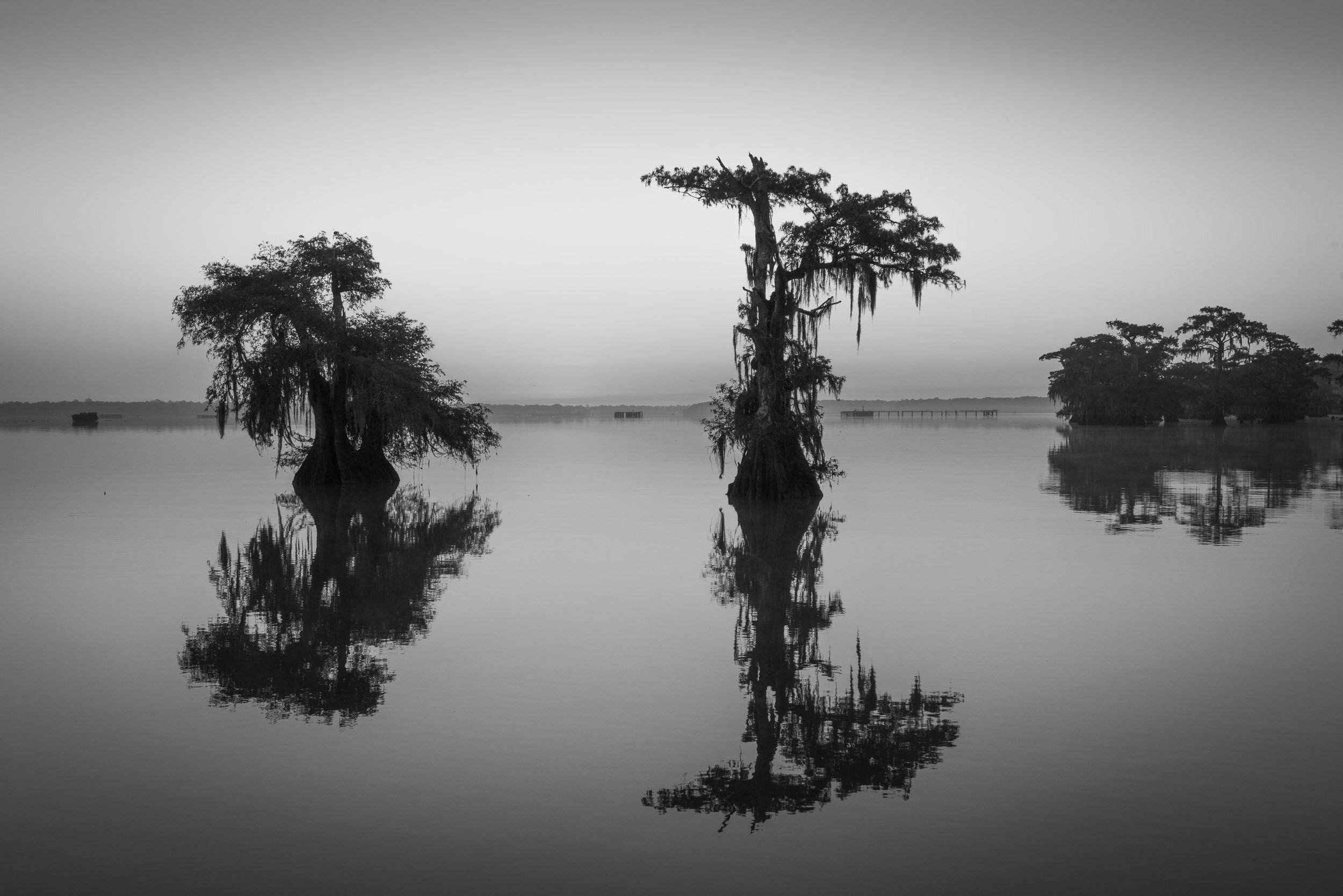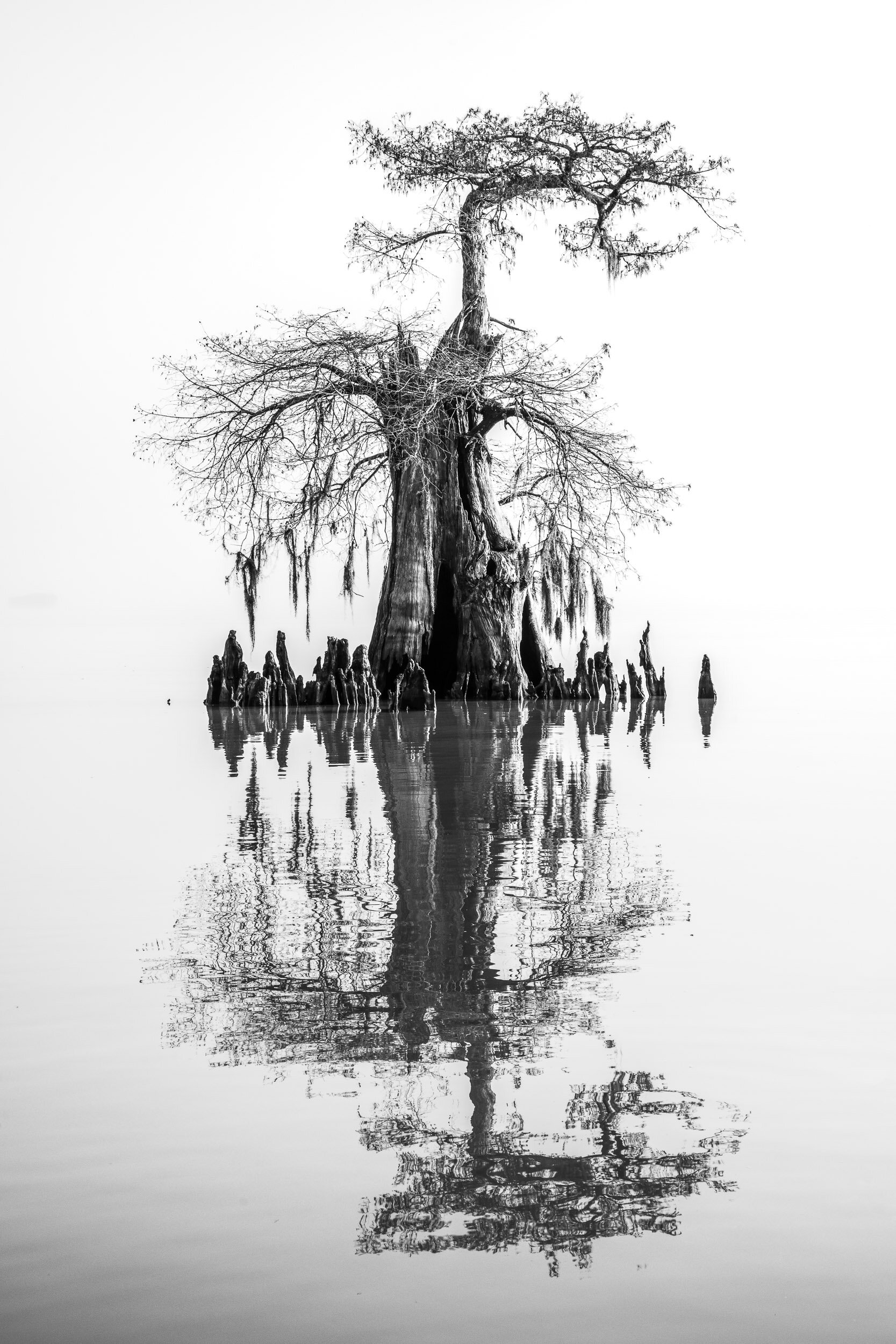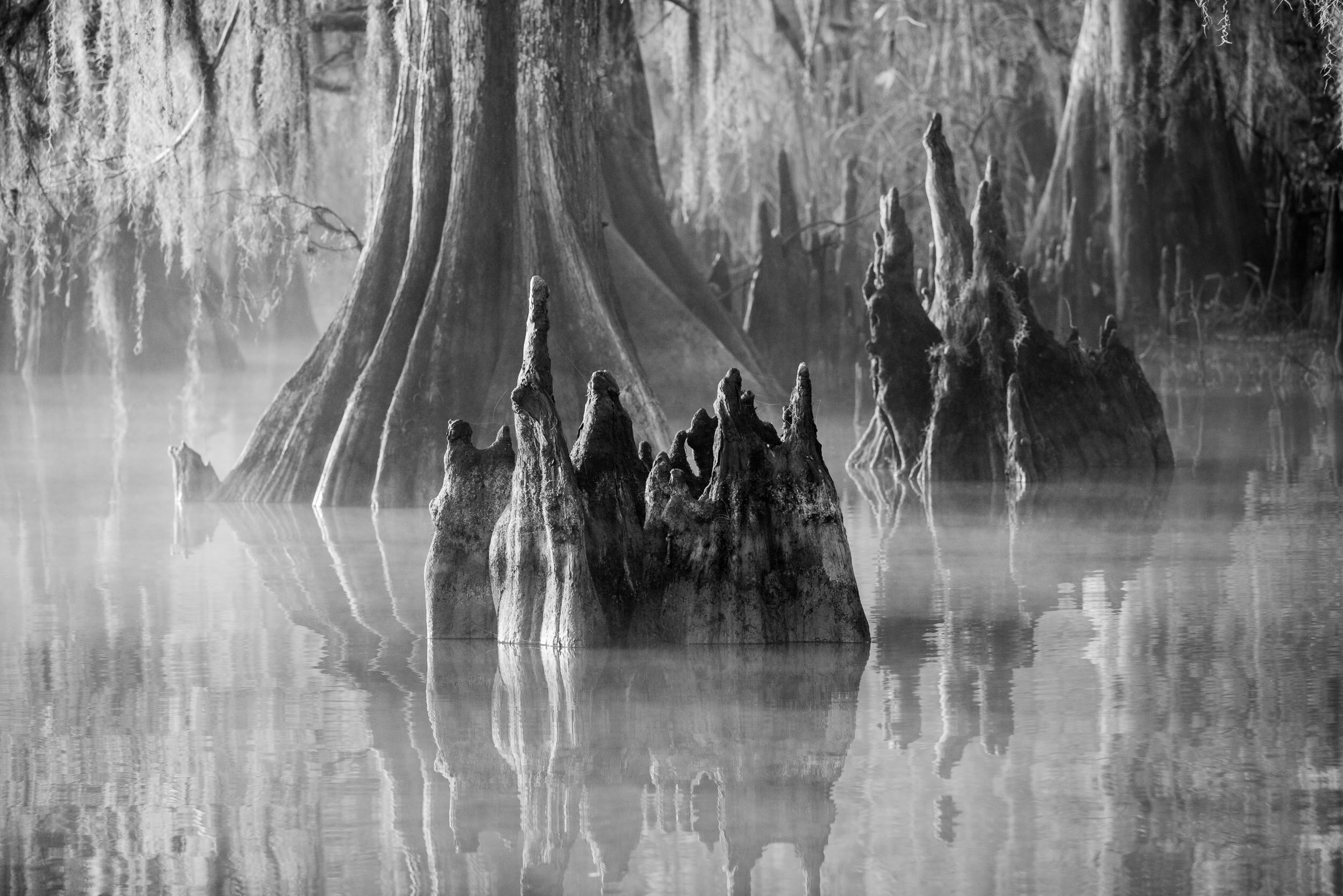Making and Processing a Black and White Image–Part I
First in a series covering the making and processing of a black and white image.
St Eloi Church Theriot, Louisiana
Image Capture
Processing an excellent Black and White Image always begins with a good capture. I captured this image on a very foggy morning south of where I live in the swampland. I left home early in the morning when the weather was clear. Unfortunately, as I approached the bridge where I planned on photographing the Pelicans, a heavy fog set it. So I decided to photograph this church instead.
The sun was directly behind the church and was illuminating the fog. I visualized the scene as a black and white image with the church in silhouette, the cross brightly illuminated to emphasized the church as the subject. In addition, I wanted to highlight the triangular shape of the church.
I used my 19mm tilt-shift lens to ensure the church was level and straight and not tilted with straight vertical lines. I set the tripod up, leveled the camera and lens, and then used the shift feature of the lens to create the composition I wanted.
The lighting was very tricky, and I had plenty of time. Therefore I decided to bracket my exposures shooting five shots, each one-stop darker than the previous shot. I carefully focused the manual focus lens, and I fired off the five-shot bracket using a cable release to minimize camera shake.
Bracketed Image Capture
Part II of the article will explore the files and deal with issues such as noise and contrast.
Photographing the Swamp in Black and White
I've been photographing the swamps here in Louisiana since I moved back in December 2001. I've focused on photographing birds and cypress scenes in color. For several years I've been drawn to rendering swamp scenes in black and white rather than in color.
Lake Dauterive Cypress Backlit Mist
Introduction
I've been photographing the swamps here in Louisiana since I moved back in December 2001. I've focused on photographing birds and cypress scenes in color. For several years I've been drawn to rendering swamp scenes in black and white rather than in color. The images begin as color images converted into photoshop or Nik Silver Efex Pro to black and white. With this approach, I apply filters in software to similate the use of color filters on the camera lens to lighten or darken parts of the image. When in the field, I often set my camera to monochrome mode to simulate how the image will appear on the back of the camera's LCD. While the camera still produces a color raw image file, it helps visualize the photograph while in the field.
On my photo tours, I often choose to photograph the scene with a black and white photograph in mind. The fall tours provide many opportunities to create the images like the ones in this post. Consider taking one of the tours to create black and white photographs like the ones show here.
Early Morning Lake Dauterieve
Composition
Composing a compelling Black and White image in the swamp is challenging. An effective black and white photos are as visually simple as possible. Without care, the tangle of Cypress trees, Spanish moss, and underbrush makes the image too busy. The careful attention to eliminating elements and getting to the essential is the key.
Foggy Morning Henderson Swamp
Without color, elements tend to merge. Careful attention to the tones of the foreground and background is essential to make the subject of the image stand out.
Cypress in Bright Morning Mist
The best Cypress Tree images are of the trees in the water. I often like to photograph so that the reflection in the water is nearly are prominant as the tree itself.
Ghost Tree in the Fog–Lake Dauterieve
Fog and Mist
Weather conditions in late November and December in Louisiana is conducive to thick fog. Fog obscures the background and makes high contrast scenes with darker tress against a bright background.
Foggy Swamp Scene–Lake Dauterieve
Mist also frequently occurs in the swamps and lakes during the winter in Louisiana. Typically this happens on frigid days where the air temperature is much colder than the water temperature. For color photography, this is excellent since the sun shining through the mist makes a golden glow. It is also great for black and white as it lends visual interest.
Cyprss Knees and Trunk–Misty Morning–Lake Dauterieve
Manmade Structures in the Swamp
In addition to the Cypress Scenes, there are many buildings and structures to photograph in black and white.
I-10 Atchafalaya Bridge at the Butte La Rose Boat Landing
St Eloi Church–Theriot, Louisiana
If you found value in this post, please consider making a donation to help me continue publishing guides and field notes like this.
Choosing the Perfect Boat for Nature Photography
Photographing nature in Southern Louisiana often means shooting from a boat. Previously, I discussed techniques for shooting in a boat. For this post, I'm talking about what type of boat to use in the swamp.
Aluminum Hulled Boat Used on my Photo Tours
Photographing nature in Southern Louisiana often means shooting from a boat. Previously, I discussed techniques for shooting in a boat. For this post, I'm talking about what type of boat to use in the swamp. Considerations include;
- The ability to get into areas with shallow water
- How quiet the boat is, mainly when photographing wildlife
- What your point of view is, you want to be low for some subjects, high for others
- The stability of the boat you don't want to fall in
- Your ability to Photograph without the boat or anyone in the boat obscuring the view
- You want to be able to transport the boat to the shooting location easily
- The ability to operate the boat while you also photograph with the camera?
- Cost
I include the following types of boats in this post:
- Skiffs
- Mud Boats
- Airboats
- Canoes
- Kayaks
- Perogues
Motor Powered Boats
Skiffs
I've been working with the folks at The Atchafalaya Experience since 2003. They use aluminum-hulled boats with outboard motors and a center console for steering and control. These boats get us into fairly tight places with several feet of water. They sit moderately low on the water so you can get a relatively low point of view, often ideal for landscapes and suitable for birds wading in the water. They are rugged and extremely safe. They are stable enough for you to stand so you can achieve a higher point of view for birds perched in trees or nesting on a treetop. They are relatively quiet, allowing reasonably close access to birds without stressing them. They can quickly cover a large area allowing you to shoot at multiple locations.
Ideal when multiple photographers are photographing and with people with limited experience operating a smaller boat that requires paddling.
Downsides include obscured vision with multiple people in the boat, vibration from the motor, difficulty transporting and launching the boat, and cases where you want to have a point of view at water level. This type of boat is best when the captain is not photographing.
Mud Boats
Gator Tail Mud Boat on the way to Cow Island Lake
Mud boats are similar to skiffs, except that they have an outboard air-cooled engine allowing them to traverse areas of little or no water. As the best swampy areas to photograph are in shallow waters, this can prove a significant advantage. My friends at Atchafalaya Experience used this type of boat for several years. However, they proved to be unreliable, and for wildlife photography, their propensity to backfire when restarting the engine proved to be problematic. These boats are as stable as the skiffs with the same issues with transporting and launching. As with the skiff, you need a dedicated captain, who is not photographing.
Airboats
A flat bottomed boat fitted with a large automotive engine and an aircraft propeller. It does not require water and can go over swampy areas. Very noisy and vibration prone. Hearing protection usually needed when in use. Wildlife doesn't tolerate the noise, and the vibrations make photography very difficult. The point of view is high, and there is little ability to move about in the boat when in use. The only practical function is to drop off photographers in remote locations not reachable in any other way. A skilled, dedicated captain is required.
Human Powered Boats
Perogues
The Perogue is the classic cajun boat used for fishing and trapping in the swamp. Originally a dugout made from a cypress tree, the most common form of it is now handmade from 1/4 inch marine or exterior plywood. Classically the boat is push polled with the person standing in the Perogue, but many people sit and paddle with a single-headed paddle. Flat bottomed, it has a very shallow draft and can operate in very shallow water. It is typically less stable than a canoe, but more stable than a Kayak. I've never photographed from a Perogue; however, many years ago, my wife and I paddled in Bayou Dularge south of Houma in one built by her Grandfather. Unfortunately, it had developed a leak, and the two of us slowly sank. I think of this when I consider photographing from one. A Perogue may be a good option for swamp photography. Perogues are inexpensive if you're able to construct it yourself, stable, quiet in the water, reasonably simple to transport, and low in the water. Like all human-powered boats, you're not able to move from one area to the next rapidly, so you need to pick your location carefully. Also, being small, you're limited to shallow protected waters; you don't want to be out in rough weather.
Kayaks
Kayaks are the modern replacement for the Perogue. Lighter and available at low cost, they don't require construction. They ride lower in the water than the Perogue so they may offer a better point of view. I haven't photographed from one, but know many who have. They represent an easy, inexpensive way to get on the water. Again, you need to pick your location, you can't quickly paddle across and a large body of water. They are quiet, easy to transport, and you can launch nearly anywhere. Typically they are paddled with a double-headed paddle, but foot-powered kayaks are available, which would leave your hands free to photograph, and you are less likely to splash water on the equipment.
Canoes
A Canoe may also be an excellent way to photograph on the water. Heavier than either the Perogue or the Kayak, they are more stable, but they are harder to transport or launch. Like the Perogue and Kayak, they are quiet and have a shallow draft. Typically they are paddled with a single-headed paddle, a disadvantage over the Kayak as it is more likely to splash water on equipment. Like the other human-powered boats, moving quickly to another location is not possible.
I've relied on motor-powered boats for the 19 years I've been doing photography in Louisiana. Over the next year, I hope to explore one or more of the human-powered alternatives to allow me to get out more on the water.
If you found value in this post, please consider making a donation to help me continue publishing guides and field notes like this.
















